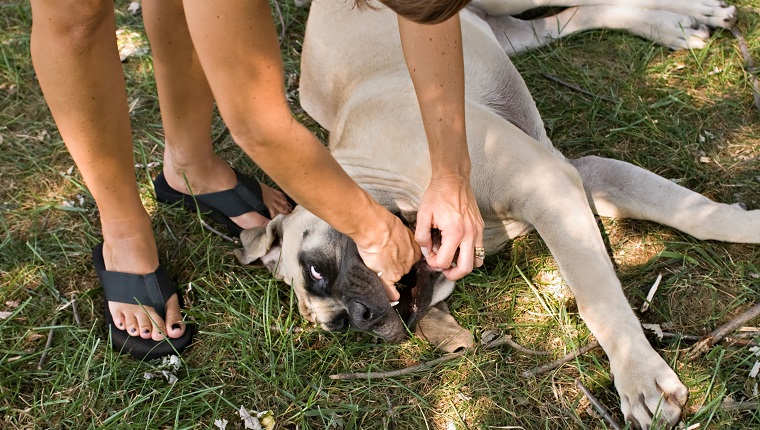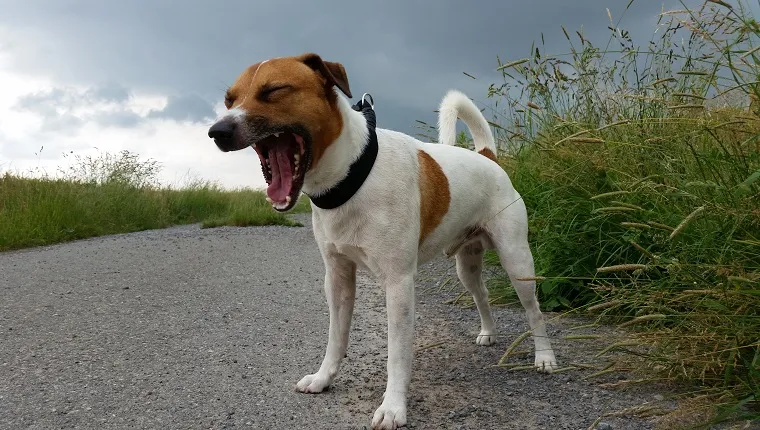If you’ve ever been researching which human foods might be safe to add to your dog’s diet, you’ll quickly realize that many foods can become choking hazards for your pooch.
The same is true with certain toys and household objects that curious canines might be tempted to chew on.
Choking is an emergency situation that requires immediate intervention. It’s caused by an object blocking the airway, preventing normal breathing.
But how should you react if you notice that your dog seems to be choking? Read on for our step-by-step guide about what to do if your dog is choking.
Watch For Signs Of Choking
The first step to dealing with a dog that is choking is to pick up on the signs. Some of the most common symptoms and signs of choking include:
- Pawing at the mouth
- Retching
- Forceful coughing
- Walking back and forth
- Pale or blue tongue
- Attempting to whine
In extreme cases of choking in dogs, an object might be blocking the airway to such an extent that they might not be able to make a sound at all. This can lead to collapse and unconsciousness
If you notice that your dog is choking, you might be able to remove the obstruction yourself or you might need to rush to your vet. Whichever decision you make, treat the choking as a life-threatening emergency.
Restrain Your Dog, Look In Their Mouth, & Try To Remove The Object

It’s important to restrain your dog. Ideally, try to place your dog on their side. A second person can help to make this process easier.
Once your dog is restrained, take a look inside their mouth and see if you notice the obstruction. You might be able to remove the object yourself using either your fingers or a pair of tweezers.
Make sure that you don’t inadvertently lodge the object further down the airway. Here are some steps to follow:
- If the dog’s still conscious, place your hand over the snout and, with their lips between your hands and their teeth, carefully but forcefully apply pressure. Reassure the dog as you do this. Be aware that they may panic and may try to bite.
- Pull out the tongue as far as possible and, if you can see the object, sweep the mouth with your finger, grasp the object, and remove it. If the dog’s conscious, be sure to maintain a very secure grip on the snout to prevent them from biting.
- If you can’t see the object, don’t try to remove it by feel. Dogs have small bones that support the tongue, which can be mistaken for foreign objects.
- If you can’t remove the object using the method above, proceed as below
Consider The Heimlich Maneuver
The Heimlich maneuver can help to dislodge an obstruction.
With small dogs, this can be performed by picking them up with their head in a raised position and their paws facing downwards and then pushing up on the hollow section under the rib cage with your fist.
This may dislodge the object. If not, you can try to pick them up by the hind legs and hold them with their head pointed down. Give them a sharp blow between the shoulder blades with the heel of your hand.
For larger dogs, you’ll want to lay your dog on their side or, if you can, hold them in your lap with their back to your chest. Wrap your hands around their abdomen from behind. Put your fists together and place them at the abdomen, just beneath the rib cage.
Compress sharply up and into the abdomen three to five times, and check to see if the object has been dislodged.
Perform CPR
If none of the above steps seem to be working, and your dog still isn’t breathing, then you’ll need to consider performing canine CPR. This process involves chest compressions and rescue breaths.
If you are unfamiliar with CPR for dogs, it’s a good idea to consult with your veterinarian ahead of time so that you’re equipped if a situation ever requires it. Techniques can vary a bit depending on the size of the dog and their breed.
The video above gives a good guide on how to handle canine CPR.
Get To An Emergency Vet
In cases of choking where none of the above steps seem to improve the problem, you’ll need to take your dog to a vet immediately.
It’s advisable to call ahead of time so that they can make accommodations to care for your dog straight away.
Even if your dog starts breathing again, it is a good idea to have your veterinarian check them out for any complications that may have arisen. This is especially true if your dog lost consciousness at any point.
Have you ever had to rescue your dog while they started to choke? Have you learned the Heimlich maneuver and CPR for dogs? Let us know in the comments below.









